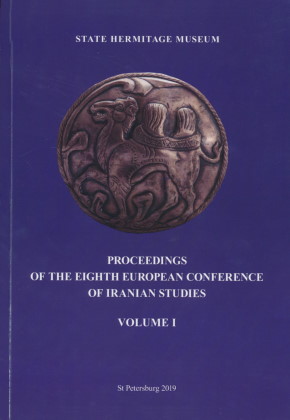 [ сборник ]
[ сборник ]
Proceedings of the Eighth European Conference of Iranian Studies
(State Hermitage Museum and Institute of Oriental Manuscripts, St Petersburg, 14-19 September 2015).
Volume I: Studies on Pre-Islamic Iran and on Historical Linguistics.
/ In English and German. St Petersburg: State Hermitage Publishers. 2019. 386 pp. + XVI colour plates. ISBN 978-5-93572-866-3 (vol. 1); ISBN 978-5-93572-869-4
Scholarly editor Pavel B. Lurje. English editor Doug Hitch.
[ аннотаци€: ]
The volume incorporates articles presented by the participants of the Eighth European Conference of Iranian Studies (in St Petersburg 14-19 September 2015) which were focused on Pre-Islamic Iran and on historical linguistics. The collected papers mirror the wide scope of Iranian studies of the present day: from business documents of Tumshuq in Xinjiang to those of the Syrian wars of the early Sasanians, from the etymology of the place-name Sudak to the pottery assemblages of Sistan of the Achaemenian period. The volume is addressed to Iranologists and specialists in neighbouring fields.
On the front cover:
Medallion with camel on a Sogdian silver lamp, 8th century,
State Hermitage Museum, St Petersburg.
—м. также Vol. 2.
Contents
EditorТs note. Ч 5
Agustí Alemany. Alans and Sogdians in the Crimea: on nomads, traders and Namengeschichten. Ч 7
Pooriya Alimoradi. Zand-i Wahman Yašt: the New Persian version. Ч 16
Pavel Basharin. Proto-Indo-Iranian and Proto-Iranian language contacts with Proto-North Caucasian. Ч 30
Julian Bogdani and Luca Colliva. Activities of the Italian archaeological mission in Iraqi Kurdistan: a preliminary report. Ч 47
Ching Chao-jung. The four cardinal directions in Tumshuqese. Ч 66
Emily J. Cottrell, Micah T. Ross. Persian astrology: Dorotheus and Zoroaster, according to the medieval Arabic sources (8th-11th century). Ч 87
Iris Colditz. Women without guardianship. Ч 106
Matteo Compareti. The Сeight divinitiesТ in Khotanese paintings: local deities or Sogdian importation. Ч 117
Maryam Dara. The comparison between the subjects and written patterns of Urartian and Old Persian royal inscriptions. Ч 133
Matteo De Chiara. Describing Pashto verbal morphology. Ч 143
Bruno Genito. Building no 3 in Dahāne-ye Gholāmān, Eastern Iran (Sistan): an Achaemenid religious puzzle. Ч 154
Sebastian Heine. Anmerkungen zur historischen Phonologic und Lexik des Kurdischen (Kurmanji). Ч 182
Camilla Insom. Reshaping sacred landscape: notes on Sufi cult in Sangaw village shrines. Ч 193
Thomas Jugel. The development of the object marker in Middle Persian. Ч 203
Nargis J. Khojaeva. Again to the question of localization of Avestan Airiianəm-Vaējō. Ч 220
Mateusz M. Kłagisz. Middle Persian Yōšt ī Fr(i)yān as ProppТs folk-tale. Ч 228
Jiulio Maresca. The pottery from Dahane-ye Gholaman (Sistan): the state of art. Ч 249
Jafar Mehr Kian, Vito Messina. The sanctuary and cemetery of Shami: research of the Iranian-Italian joint expedition in Khuzistan at Kal-e Chendar. Ч 271
S. Fatemeh Musavi. Pahlavi and Sanskrit interpretations of Gāϑā 31, an analysis. Ч 286
Ogihara Hirotoshi. Tumshuqese imperfect and its related forms. Ч 297
Filip Paluncic. Ossetic historical phonology and North-Eastern Iranian anthroponomastics from the North Pontic region 1st-5th c.CE. Ч 311
Gabriele Puschnigg. Functional variation in pottery repertoires from the Parthian and Sasanian period. Ч 330
Chiara Riminucci. Parokṣakámá hi devàh Дdenn die Götter lieben das MysteriöseФ. Zur Komposition des Bahrām-Yašt. Ч 350
Ehsan Shavarebi. Sasanians, Arsacids, Aramaeans: Ibn al-KalbīТs account of ArdashīrТs Western campaign. Ч 363
Fahimeh Tasalli Bakhsh. Speech representation in Yashts; a narratological approach. Ч 379
Abbreviations. Ч 385
|